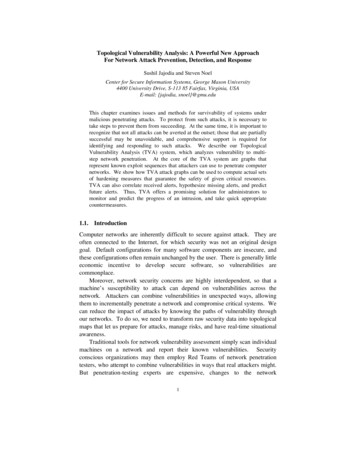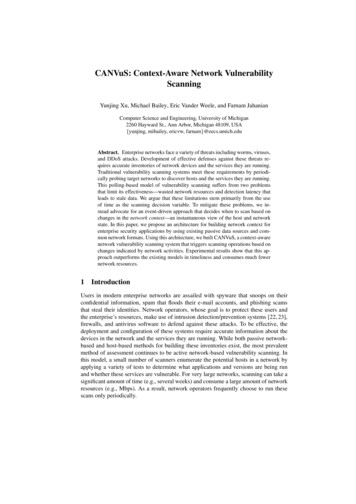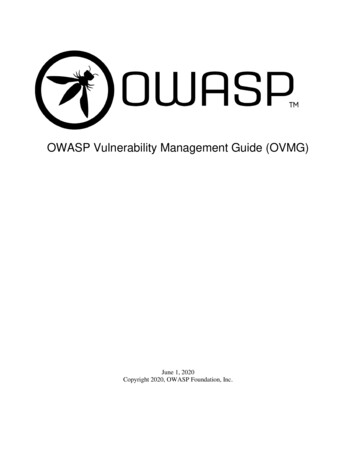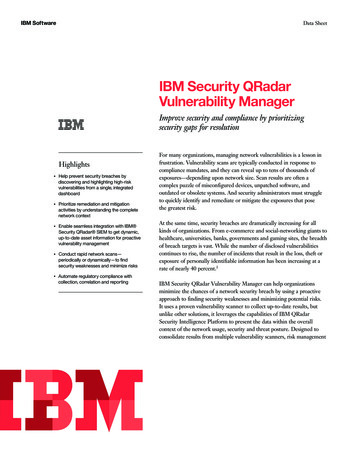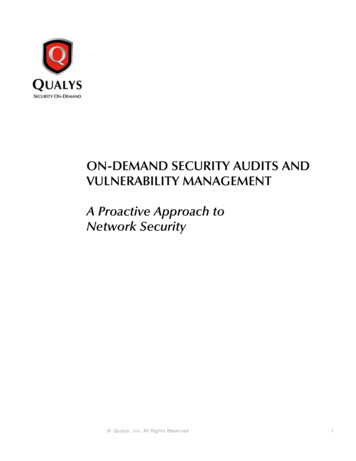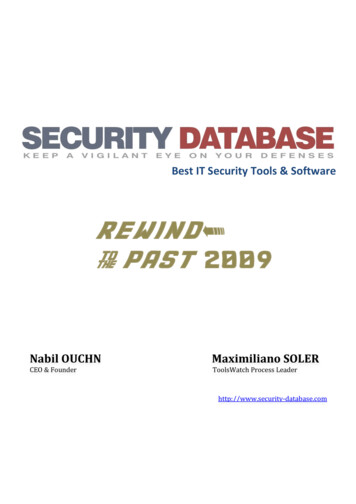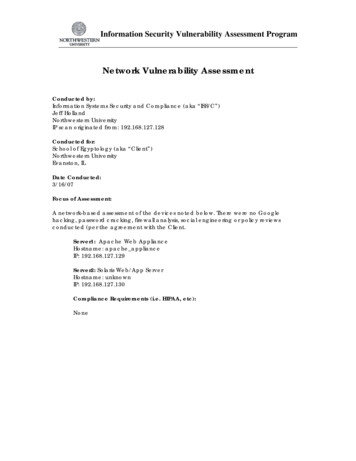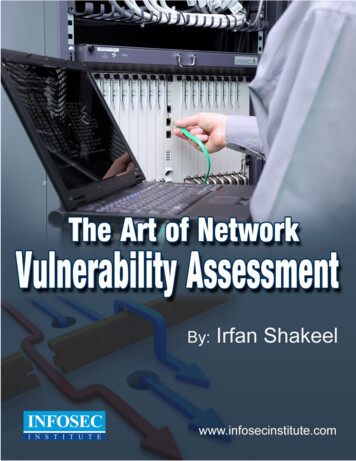
Transcription
Peter KleinertFeb 2018 @ TF-CSIRT meeting andFIRST Regional Symposium EuropeEnhancing OS vulnerability scanners:from a single box to hardened multi-node scan clusters
Introduction Developer, consultant, SaaS architect, DevOps lead @ SAP
Introduction Co-founder of Binary Confidence
Introduction Developer, consultant, SaaS architect, DevOps lead @ SAP Co-founder of Binary Confidence:–––––Expert ConsultancyTrainings and live simulationsMSSPSecurity Operations Centre (SOC)Emergency Response Team
MSSP Encryption box Log & data collectionInfra. and self monitoringPatch managementVulnerability scanningOpenVAS slaveruns hereOpenVAS masterand repos
The ChallengeGuys, we need to automate our network scanning! Are you in? Critical infrastructureSeveral datacentersHundred(s) VLANsThousands devicesAir-gapped.yet cost effective
The Options Greenbone /OpenVAS Nessus Rapid7 Qualys
The Options Greenbone /OpenVAS Nessus Rapid7 Qualys
What we got? Open Source w. community updates Web UI - GSAAPI and CLI – OpenVAS ManagerScalability Master supports 15 slaves and 150 tasks Configurability Multiple output formats (PDF, HTML, CSV, XML) Reporting incl. Σ and Δ
Reported dataHigh (CVSS: 7.5)80/tcpNVT: phpinfo() output accessible (OID: 1.3.6.1.4.1.25623.1.0.11229)SummaryMany PHP installation tutorials instruct the user to create a file called phpinfo.php or similarcontaining the phpinfo() statement. Such a file is often times left in webserver directory aftercompletion.Vulnerability Detection ResultThe following files are calling the function phpinfo() which disclose potentially sensitiveinformation to the remote attacker: http://metasploitable/phpinfo.phpImpactSome of the information that can be gathered from this file includes: The username of the userwho installed php, if they are a SUDO user, the IP address of the host, the web server version,the system version(unix / linux), and the root directory of the web server.Solution type: WorkaroundDelete them or restrict access to the listened files.Vulnerability Detection MethodDetails: phpinfo() output accessible (OID: 1.3.6.1.4.1.25623.1.0.11229)
What else do we need?OK, we‘ve got the foundation,what else do we need?1. Fast installation
What else do we need?OK, we‘ve got the foundation, what else do we need?1. Fast installation and final deployment2. Runninga. Reconfigurationsb. Security Monitoringc. Operation Monitoring3. Air-gap support - updates4. Simple and safe HL communication5. Backups and High-availability6. Hardening
OpenVAS
The IngredientsMaster on Ubuntu 16.04 OpenVAS 9 GSA OpenVAS 9 Manager OpenVAS 9 Scanner SSHD for tunneling Zabbix 3.0 server&agent Salt 2017.7 master&minion OS updates repo (HTTP) OpenVAS 9 repo (RSYNC) OSSEC / Logstash / (ELK)GSAZabbixSSHSSH tunnelSlaves on Ubuntu 16.04Ubuntu16.04 LTS SlaveOpenVAS9 ManagerSlave Ubuntu16.04 LTSSlaveUbuntu16.04 LTS OpenVAS9Manager OpenVAS9 Scanner OpenVAS9 Manager OpenVAS9 ManagerOpenVASScanner AutoSSHfor9tunneling OpenVAS9 Scanner 3.0OpenVAS9 ScannerAutoSSHfor tunneling Zabbixagent AutoSSH for tunneling AutoSSHfor tunneling Zabbix3.0minionagent Salt2017.7 Rsyslog/ Beats Zabbix3.0 agent Zabbix3.0 agent Salt 2017.7 minion Salt 2017.7 minion Salt 2017.7 minion- OpenVAS- Zabbix - Rsync - HTTP (apt-mirror) - Salt - Syslog / Logstash
HW Requirements Mini PCs: 1.2 LAN ports 1U servers: 6.10 LAN portsMaster Single master / HA For 15 slaves: 2 cores, 4GB RAM, 128GB disk, no scanningSlave Value: 1 core, 2GB RAM, 32GB disk Optimal: 2-4 cores, 4GB RAM, 64GB disk
Communications External O- M communication does support 2FA– OpenVAS GSA&Zabbix: TCP 443 O- M and SSH: TCP 22 O- M All M - S communication tunneled - autoSSH–––––OpenVAS scanner: TCP 9390 M- SZabbix monitoring: TCP 10050 M- SSalt remote execution: TCP 4505, 4506 S- MOpenVAS RSYNC: TCP 873 S- MOS & services updates: TCP 80 S- M Approx. data transfer:– Idle:M- S: 60 kbps, S- M: 80kbps– Scan:M- S: 100 kbps, S- M: 100kbps– Update: M- S: megabytes for a weekly update
Deployment & add scanner From Sources vs. Packages vs. Upgrades SVN - GitHub: https://github.com/greenbone tools/openvas-check-setup CA Certificate of slave: Create a user on slave:/var/lib/openvas/CA/openvasmd --user creds01--v9
OpenVAS tools: CLI/Python/Dialog GitHub: https://github.com/greenbone/gvm-tools– gvn-cli – XML– gvm-pyshell – Python3– Even on Windows: gvm-cli.exe & gvm-pyshell.exe Other interesting projects:– https://github.com/mikesplain/openvas-docker– https://www.seccubus.com/
Automation New slave deployment:– USB key w preseeded Ubuntu Server– MAC 2 hostname&IP– Run Salt-minion Update packages Update deployment Routine maintenance
Monitoring OS, basic/added services, ports and updates Utilization – don‘t overutilize existing infrastructure Master-Slave connectivity OpenVAS services and portsService statusTasks and resultsUpdate status and timestamps Negative checks Reporting to operators
Under development Automated delta reportsAuto ticket creation for critical/high vulnerabilitiesFindings to Elastic ster HACluster basic auto healing
Don‘t forget about these Make sure everyone knows Adjust your monitoring Brute force / Default creds? Hardening Work instructions False sense of security Scheduling / utilization:– Lines M - S, S - T– Master, Scanner or Targets
Takeaways1. OpenVAS – stable and amendable foundation to start with2. Automate everything: Preseed USB, Zabbix, Saltstack3. Communicate to SOC, educate operators (false sense of security)
Thank you!Your Private GuardiansPeter KleinertCTO & inconf.com
Developer, consultant, SaaS architect, DevOps lead @ SAP Co-founder of Binary Confidence: – Expert Consultancy – Trainings and live simulations – MSSP – Security Operations Centre (SOC) – Emergency Response Team. MSSP Enc
